Schedule Your Fishing Charter Accordingly |
To Every Thing There Is A Season, |
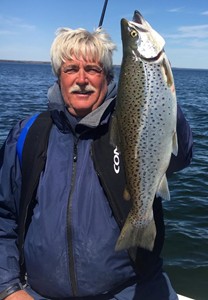 |
|
We are blessed with a diverse, multi species fishery in Lake Champlain. There are seventy two indigenous fish varieties, and at least sixteen non-native species currently living in the lake. Approximately twenty different types of pan, sport and game fish are enthusiastically pursued by fishermen. While most of these sought after species can be caught year round, proficient anglers know that the characteristics and behaviors of each differ, and there are favored open water seasons to target them for best numbers and size. A versatile fisherman knows the prime seasons to fish for each particular variety and which applications or methods to employ for the most success and enjoyment.
|
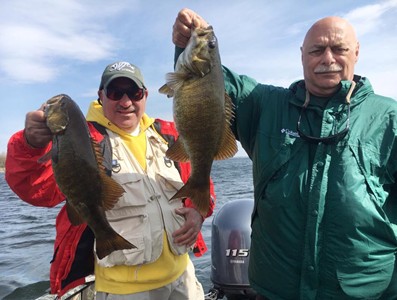 |
|
As the seasons evolve the advanced angler must transition from one tactic to another to make the most of the best opportunities each specie presents within a particular time of year. Water temperatures dictate much of the behavioral changes so time frames may differ in other regions of the country. The following suggested open water months apply specifically to the Lake Champlain basin. They are the general rule and may vary with volatile or unusual weather patterns.
Prime Time for Smallmouth Bass: April, May, October and November Soon after the ice goes out from Lake Champlain the tributaries and shallow bays of the lake begin to warm. This is one of two spectacular times to fish for smallmouth bass. The big mature female bass ascend from the depths into moderately shallow water to stage prior to their spawn. Slowly offered jigs with soft plastics, and jerkbaits or crankbaits retrieved with a stop and go presentation are good options at this time of year. The fish will be most active when surface water temps are between 45-55 degrees. As soon as temps reach the upper 50s and low 60s the smallmouth spawn and they’re somewhat tougher to catch. Again in late fall the big smallmouth will group up on reefs and shoals in 15-40 feet of water and feed up for the long winter ahead. This also requires a slower presentation with jigs or tubes being the premier lures of choice. The bite continues into late November as surface water temperatures dip into the low 40s. During these cool spring and fall seasons the female bass are schooling in reasonably shallow water. They’re chunky, egg laden and on the feed. |
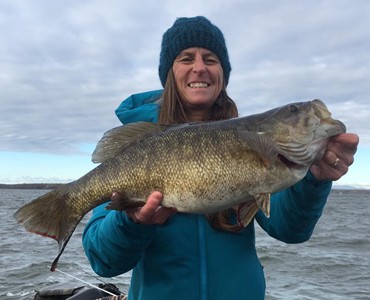 Most readers have undoubtedly heard the famous biblical passage, “To every thing there is a season”. The phrase was underscored in the 1950s song, Turn Turn Turn written by Pete Seeger, and its better known version rerecorded by the Byrds in the 1960s. And so it is with fishing. Early spring and late fall temperatures may be cold but the smallmouth bass fishing is on fire! The time to reap is when the fishing is most productive. |
Best Largemouth Bass Fishing Periods: May, June, September Largemouth bass are typically a few weeks behind the smallmouth in the spring as both species approach their spawning periods. They’re very active feeders prior to their spawn, beginning when water temperatures reach the mid 40s. Crankbaits, jigs and soft plastics are excellent choices to apply during this time frame. When temps reach the mid to upper 60s the largemouth bass go into their spawn. During the spawn, when the big green females are bedding, they are difficult to catch. They are also finicky for several weeks post-spawn. Once they’ve recovered they become active again. It’s during this period that anglers will have great success using top water baits and soft plastics fished in heavy cover. Unlike smallmouth bass, these fish thrive in warmer water and can be targeted throughout the summer in shallow weed beds along shorelines or around structure like timber, docks, reefs and rock piles. In September as the days grow shorter and the water cools the largemouth bass will feed heavily yet again. Some of the biggest bass are caught during the September blitz. |
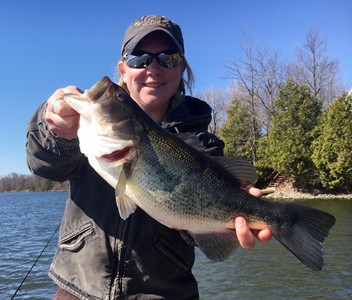 Monster largemouth bass like this specimen are targeted by knowledgeable fishermen during spring pre-spawn periods and again in autumn as weed beds thin out with cooling temperatures and shorter days. |
Favorable Northern Pike Fishing: May, September, and early October Like bass, northern pike are also staging in shallow water in May as their spawning season approaches. They aggressively defend their territory in the pre-spawn stage. Big females can be found lurking in close proximity to shorelines and back water spawning flats. Jerkbaits and swimbaits fished with an erratic ripping action work well to entice the massive marauders to strike. In the fall the days get shorter and water temperatures cool. Aquatic vegetation begins to break up and die. Weed beds gradually thin out and the big predator pike roam into the shallows looking for vulnerable baitfish exposed by the process. This is a great time of year to fish a spinnerbait or favorite spoon with a fast retrieve. A jerkbait with a flashy erratic action is also very productive in the fall. In early to mid October Lake Champlain’s water temperatures drop dramatically and the big pike move back into slightly deeper water and become more difficult to locate. |
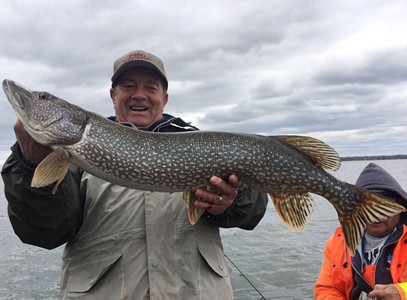 Great northern pike are best targeted during their pre-spawn period in early May and again in September when the biggest of the lake’s toothy beasts come into the shallows. Erratic and quick fleeing baits are irresistible to the apex predators. |
Optimal Atlantic Salmon and Brown Trout Fishing: April, May, October and November As soon as the tributaries of Lake Champlain open up in late March and early April Atlantic salmon begin their foraging run over the deltas and up stream into the warm spring run off. Brown trout that wintered over in the rivers are also present and are often the first fish to be caught by river anglers. The salmon and trout fishing is excellent throughout April and May wherever fishermen can find moving water and baitfish. By the end of May boats trolling off the tributary deltas and in pinch points around the lake are catching good numbers of schooling fish following bait that is on the move toward cooler waters. Small spoons and stickbaits are perfect lures to take trout and salmon in the spring. Salmon enthusiasts will troll throughout the summer, but the fish are somewhat tougher to catch as the lake’s surface water warms above the mid 60s and they scatter into the water column. By fall the salmon and brown trout congregate closer to the surface once again making the months of October and November great times to target them trolling. As the lake’s surface water temps drop through the 50’s the fall spawning run occurs on the rivers and the biggest of the mature breeders can be caught in the tributaries again. Nymphs and egg patterns are excellent options for fly fishermen in the tributaries during the fall run. Be advised that special regulations exist on many tributaries to protect spawning salmon. |
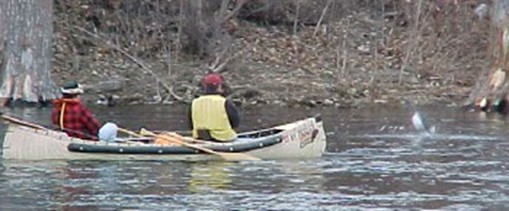 Atlantic salmon are known as “The King of Gamefish”. They’re acrobatic leapers that provide intense excitement for anglers in spring and fall when the very best numbers of fish are grouped up in and around tributaries and other areas with significant current on Lake Champlain. |
Select Lake Trout Periods: Trolling - April and May. Jigging – June, July and August Lake Champlain’s robust lake trout, or freshwater char, make a great target specie from ice-out through early September. When fished properly they too can provide awesome fishing experience. When trolling in April and May the action is less interactive for the fishermen. Most anglers prefer getting involved in the fishing action by removing the rod from the downrigger, setting the hook if necessary and most importantly, feeling the fight. Putting the boat in neutral when a fish hooks up allows for a better trolling experience. Spoons, stickbaits and large Christmas tree spinners are lures used when trolling in spring. As soon as possible this Captain switches over to a jigging application. This occurs in mid June when fish begin to show up on deepwater structure in mass. With a properly equipped vessel fishermen are able to quietly hold on the structure and fish vertically. The method is much more interactive for anglers. They feel the strike and battle the fish from the bottom to the top. It’s amazing how much better the fight is when jigging is compared to trolling. Additionally, when jigging the hooked fish are able to decompress and burp as they come up, allowing for a more successful release and survival rate in deep summer. Leadhead jigs with soft plastics and various jigging spoons are great choices for lures. When bass and pike fishing is tougher in deep summer I’ll suggest the the lake trout jigging option. It is exceptional! |
 Deep water vertical jigging is an exciting way to fish for lake trout! The method enables the angler to pursue the biggest fish in the school. This trout was over 14 pounds when caught in late August. |
As a conscientious professional guide and charter Captain I am obliged to provide honest information to my clients. Depending on their specie preference, I’ll advise them of the best times of year to schedule a trip. This increases their odds of catching as many quality fish as possible and insures an enjoyable and memorable experience. Taking advantage of the prime seasons is key to being successful throughout the year, day in and day out. |
 This trout was nearly 17 pounds when caught by the author in mid August. |
|
|
| Back to the main page |